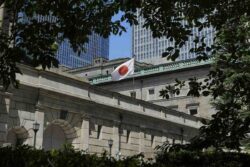10:35 JST, January 4, 2022
HANOI — In Southeast Asia, where marine plastic pollution has become a serious problem, incineration facilities for plastic garbage are being constructed with Japan’s assistance.
By establishing incineration as a way to deal with plastic waste in the region, it is hoped the amount of plastic garbage stored in the open air will be reduced, and that the environment will be improved as a result.
In Vietnam, the construction of a waste-burning, power-generating facility is scheduled to start in January in Bac Ninh Province in the north of the country. It will be the largest of its kind in the country. Vietnam aims to complete construction by January 2024.
JFE Engineering Corp., a leading engineering company for building plants and similar facilities, will design and construct the facility, which will use incineration technology to burn both household garbage and industrial waste efficiently and simultaneously. It will also assume operation of the plant following its completion. The Japanese government will bear part of the construction cost.
As this technology is highly regarded around the world, JFE Engineering has taken on the construction of similar facilities in such countries as Britain and Germany.
Electricity will also be generated by harnessing the heat produced by burning waste.
In Vietnam, it is assumed that about 92,000 megawatt-hours will be generated annually by burning 500 tons of garbage every day. There are also plans to sell some of the electricity generated to Vietnam’s electric power public corporation.
China was once the world’s largest importer of plastic waste, but after it banned such imports at the end of 2017, countries in Southeast Asia have become alternative destinations.
As a region, Southeast Asia has long been a mass consumer of single-use plastic products, such as plastic bottles and bags.
The plastic waste left untreated and stored in the open air has ended up in the sea and then been unwittingly consumed by marine organisms such as fish, causing them harm. Such incidents have been widely reported, and plastic pollution has become a social issue.
According to an estimate made in 2010 by a group of U.S. scientists and released in 2015, five Southeast Asian countries, including Vietnam and Indonesia, accounted for nearly 30% of all plastic waste produced worldwide. Plastic waste produced in the region has since risen even further.
Japan has been striving to offer policy assistance on waste treatment to Southeast Asian countries over about 10 years.
Placing importance on dealing with plastic waste, Japan assisted in the construction of a waste-burning, power-generating facility in Yangon, the biggest city in Myanmar, helping it start operation in 2017.
In addition to the ongoing assistance to Vietnam, moves toward a similar plant are also underway in Indonesia.
"World" POPULAR ARTICLE
-

8 Japanese Nationals Stranded on Indonesia’s Sumatra Island
-

Mozambican Cooking Class Held in Matsuyama, Ehime Pref.; Participants Don Aprons, Bandanas Made from Traditional Mozambique Fabric
-

China to Impose Sanctions on Shigeru Iwasaki, Former Head of Japan’s Self-Defense Forces, Who Serves as Adviser to Taiwan’s Executive Branch
-

China Steps Up ‘Wolf Warrior’ Diplomacy Against Japan, Hurling Accusation About Plutonium Stockpile
-

South Korea’s Top Court Dismisses Nippon Steel Appeal in Lawsuit over Requisitioned Worker
JN ACCESS RANKING
-

Keidanren Chairman Yoshinobu Tsutsui Visits Kashiwazaki-Kariwa Nuclear Power Plant; Inspects New Emergency Safety System
-

Imports of Rare Earths from China Facing Delays, May Be Caused by Deterioration of Japan-China Relations
-

Japan Pulls out of Vietnam Nuclear Project, Complicating Hanoi’s Power Plans
-

Govt Aims to Expand NISA Program Lineup, Abolish Age Restriction
-

Blanket Eel Trade Restrictions Rejected

























